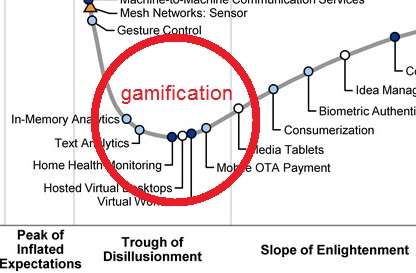Bad Gamification Is Still Bad
It’s been nearly a year since we’ve first heard Gartner’s prediction on how “80 Percent of Current Gamified Applications Will Fail to Meet Business Objectives Primarily Due to Poor Design” was first uttered and CMSWire recently did a follow up with Gartner’s Brian Burke to see if they’re still sticking with this statement.
Their response? It’s still on track.
This really comes as no surprise given that the vast majority of gamification implementations are still shallow implementations of points, badges, and leaderboards without any viable long-term engagement. This statement is simply reaffirms Gabe Zichermann’s response to this article last year, which simply calls gamification designers together to make great gamification.
While they’re sticking with the statistic as gamification moves towards the “trough of disillusionment” in the Gartner hype cycle, Burke did have some additional viewpoints on where gamification is heading in 2014 regarding gamification’s potential for long-term engagement and current trends.
According to Burke, the long-lasting positive effects of gamification can be seen purely in the “scale of engagement” in digital models. This statement is questionable due to the fact that getting many people to engage with gamification does not mean they will continue to do so over-time. Press releases with case study numbers resembling 1000% increases in engagement are very impressive and only possible due to digital platforms but these are not numbers of engagement one can truly expect to see on a long-term basis.
In fact, tell any manager that your new initiative raised engagement by 1000% and they’ll be shocked and expect you to raise it to 1100% by next year. Scale is certainly important but it isn’t solely indicative of long-term success.
Burke also mentions an industry shift from consumer-focused initiatives to employee-facing initiatives as well as gamification playing a big role in reinventing education. The shift towards employee-facing initiatives is a valid observation; given that big companies like Delta, IBM, and Microsoft are using gamification to engage with their employees and publicly talking about it. When you consider the traditional model of learning through humdrum manuals and lackluster quizzes and compare it to game-based learning, social learning, and simulation training, there’s not much of an argument to be made for the old model.
And it’s these exact same principles being applied towards training that will be reinventing education in the future as well. It’s interesting that we’re always discussing the context of education within the silos of strictly “business” or “classroom learning” but the end-goal (and I would even argue the learners) is the same: the acquisition of knowledge.
Gamification is maturing and while people are still stuck on the semantic argument of gamification and “wondering if it’s a fad”, we’re still seeing tons of compelling evidence from big companies about how gamification can work. It’s just looking like those dedicated to using gamification are doing alot of testing and designing very specific and personalized solutions as opposed to shallow implementations of yesteryear.
As we head towards GSummit 2014 in the new year, I’m looking forward to all the solutions designers are coming up with to be in the fabled 20% of “awesome gamification”.









This article is very importat to reflect the future gamified actions.
very important news